控制果蔬采后病害的生物学技术
- 格式:pdf
- 大小:252.22 KB
- 文档页数:7
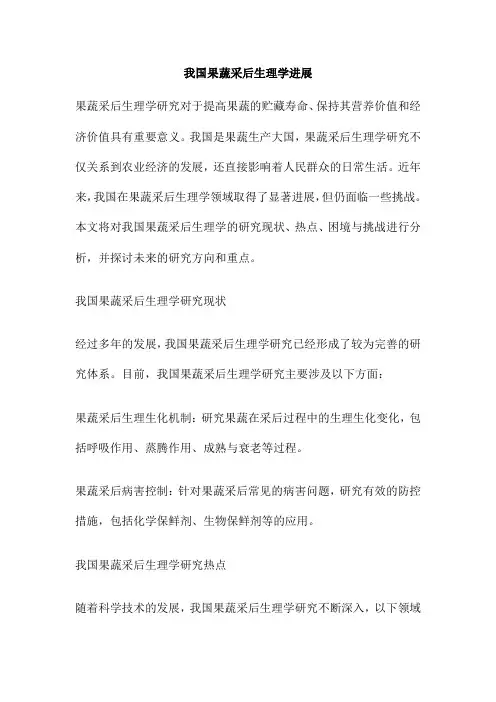
我国果蔬采后生理学进展果蔬采后生理学研究对于提高果蔬的贮藏寿命、保持其营养价值和经济价值具有重要意义。
我国是果蔬生产大国,果蔬采后生理学研究不仅关系到农业经济的发展,还直接影响着人民群众的日常生活。
近年来,我国在果蔬采后生理学领域取得了显著进展,但仍面临一些挑战。
本文将对我国果蔬采后生理学的研究现状、热点、困境与挑战进行分析,并探讨未来的研究方向和重点。
我国果蔬采后生理学研究现状经过多年的发展,我国果蔬采后生理学研究已经形成了较为完善的研究体系。
目前,我国果蔬采后生理学研究主要涉及以下方面:果蔬采后生理生化机制:研究果蔬在采后过程中的生理生化变化,包括呼吸作用、蒸腾作用、成熟与衰老等过程。
果蔬采后病害控制:针对果蔬采后常见的病害问题,研究有效的防控措施,包括化学保鲜剂、生物保鲜剂等的应用。
我国果蔬采后生理学研究热点随着科学技术的发展,我国果蔬采后生理学研究不断深入,以下领域成为研究热点:基因组学在果蔬采后生理学中的应用:通过基因组学手段研究果蔬在采后过程中的基因表达变化,有助于深入了解果蔬的衰老机制,为贮藏保鲜提供理论支持。
代谢组学在果蔬采后生理学中的应用:代谢组学的是生物体受环境刺激或基因改变引起的代谢产物的动态变化,将其应用于果蔬采后生理学研究,有助于揭示果蔬贮藏过程中的代谢变化和营养价值的衰减过程。
我国果蔬采后生理学研究困境与挑战尽管我国果蔬采后生理学研究取得了显著进展,但仍存在一些问题和挑战:基础研究薄弱:与国际先进水平相比,我国在果蔬采后生理学的基础研究方面还存在不足,这限制了我们在该领域的进一步发展。
技术手段缺乏:虽然基因组学、代谢组学等新技术为果蔬采后生理学研究带来了新的机遇,但我国在相关技术手段的应用方面尚存在较大差距。
农业与科教结合不紧密:在农业生产和科教方面,我国果蔬产区和科教单位之间的不够紧密,导致部分研究成果难以转化为实际应用。
总体来看,我国果蔬采后生理学研究已经取得了显著进展,但仍面临诸多挑战。
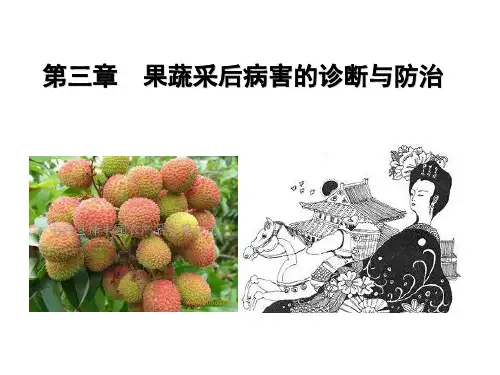

2023-11-06CATALOGUE 目录•果品蔬菜采后病虫害概述•常见果品蔬菜采后病虫害类型•果品蔬菜采后病虫害防治技术•案例分析与实践经验分享•前瞻性与未来研究方向01果品蔬菜采后病虫害概述果品蔬菜采后病虫害是指病原微生物在适宜的条件下对果品蔬菜造成损害的生物灾害。
定义果品蔬菜采后病虫害可分为真菌性病害、细菌性病害、病毒性病害等。
分类定义与分类发生原因果品蔬菜采后病虫害的发生原因主要包括品种抗病性差、环境条件不适宜、栽培管理不当等。
传播途径果品蔬菜采后病虫害主要通过气流、水、昆虫等媒介进行传播。
发生原因与传播途径防治方法果品蔬菜采后病虫害的防治方法主要包括农业防治、物理防治、化学防治等。
意义果品蔬菜采后病虫害的防治对于保障食品安全、提高果品蔬菜的品质和产量、增加农民收入等方面具有重要意义。
防治方法与意义02常见果品蔬菜采后病虫害类型疫病疫病主要发生在湿度较高的地区,它会导致果品蔬菜表面出现大量的白色菌丝,并逐渐扩散,最终导致果品蔬菜全部腐烂。
果品蔬菜病害灰霉病果品蔬菜在采收后容易发生灰霉病,该病主要由真菌引起,导致果品蔬菜出现水渍状病斑,并逐渐扩大,最终引起腐烂和变质。
软腐病软腐病也是一种常见的果品蔬菜病害,主要发生在蔬菜的根茎部位,导致组织软化、腐烂,并散发出恶臭气味。
炭疽病炭疽病主要发生在热带和亚热带地区,它会导致果品蔬菜表面出现许多小斑点,并逐渐扩大,颜色也会逐渐加深,最终导致果品蔬菜变质。
甲壳类害虫甲壳类害虫主要是一些甲壳虫类昆虫,它们会啃食果品蔬菜的叶片、茎和果实,导致植物组织损伤、落花落果和品质下降。
蛾类害虫蛾类害虫是一种常见的果品蔬菜虫害,它们会啃食果品蔬菜的叶片、花和果实,导致植物组织损伤、落花落果和品质下降。
蚜虫类害虫蚜虫类害虫是一种常见的果品蔬菜虫害,它们会聚集在植物的叶片、茎和花上,吸取植物的汁液,导致植物组织损伤、落花落果和品质下降。
果品蔬菜虫害03果品蔬菜采后病虫害防治技术农业防治选择对病虫害抵抗力强的品种,从源头上减少病虫害的发生。
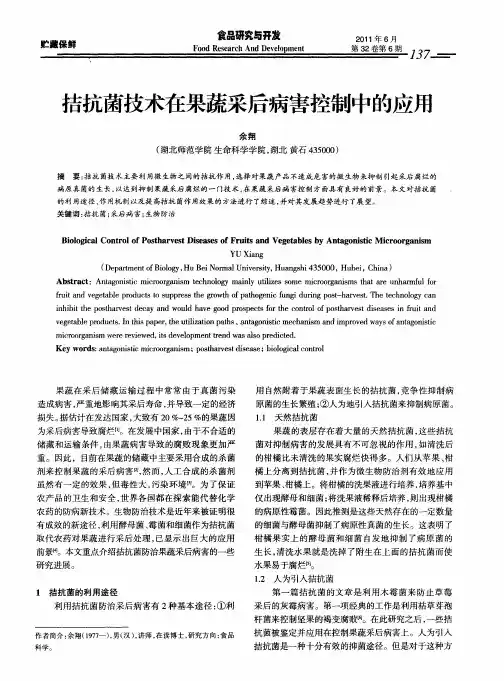
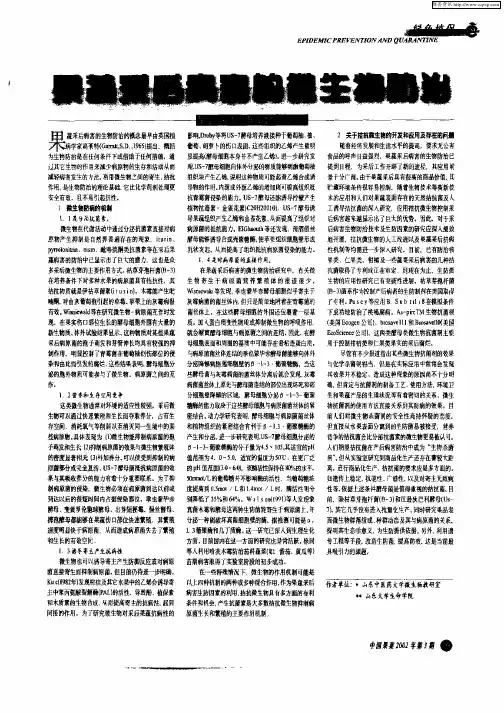
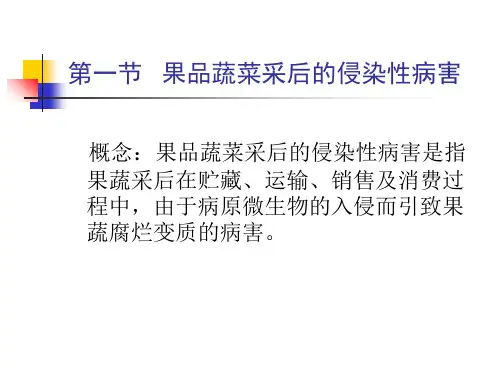
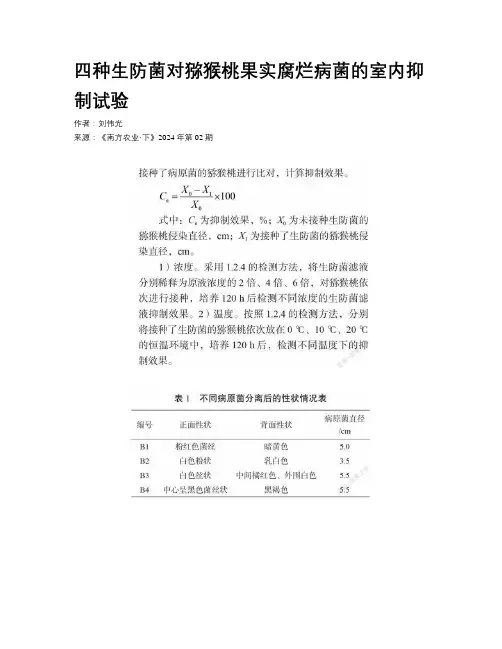
四种生防菌对猕猴桃果实腐烂病菌的室内抑制试验作者:***来源:《南方农业·下》2024年第02期摘要當前人们对于果蔬品质的要求不断提高,为切实做好果蔬采后病害控制,此次以猕猴桃为例,通过病原菌提取、致病性检测、制作无菌液、病原菌抑制效果检测,分析不同生防菌对于猕猴桃中所含病原菌的抑制效果,探究现阶段在不对人体造成危害的前提下,能够有效控制果蔬采后病害的生物学技术。
结果表明,在不同生防菌对病原菌的抑制测试中,BAR1-5的抑制效果最明显,对B1、B2、B3、B4病原菌的抑菌带宽度均在8.0 mm以上,尤其是对B1、B3病原菌的抑菌带宽度在11.5 mm及以上。
关键词生物学技术;采后病害控制;猕猴桃;陕西省宝鸡市眉县中图分类号:S436.3;S436.6 文献标志码:A DOI:10.19415/ki.1673-890x.2024.04.001通过调查可知,在众多果蔬中,猕猴桃的采后病害情况尤为严重,在采后的运输、储存、售卖过程中,受到多种因素的影响,大批量猕猴桃出现腐烂情况[1]。
从当下国内外对猕猴桃采后病害的研究现状来看,普遍对采后病害的研究仅限于病原菌鉴定,如软腐病、灰霉病、黑星病等,对于如何采取生物学技术对猕猴桃采后病害进行有效控制,缺乏具体化的研究成果[2]。
此次试验通过分离猕猴桃果实上的4种病原菌,然后利用效果较好的生防菌进行测试,深入分析了不同环境下的防治效果差异,进而初步制订出科学、合理的使用方法,为陕西省宝鸡市眉县控制猕猴桃采后病害提供有效的生物学技术支持。
1 材料与方法1.1 试验材料1)病菌材料。
此次试验通过病原菌分离法,从具有采后病害的眉县猕猴桃中分离出4种病原菌,分别编号为B1、B2、B3、B4。
2)生防材料。
采用广州市农业科学研究院果树研究所提取的X1、D3-2、GK、BAR1-5共4种生防菌种,放入-90 ℃的超低温冰箱储存。
3)培养基材料。
①生防菌培养基:分别配备黄豆粉培养基、发酵培养基、高氏一号培养基。
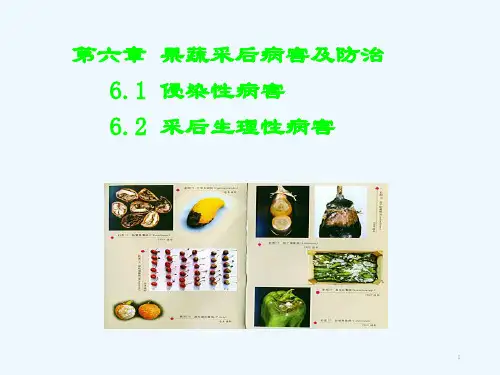
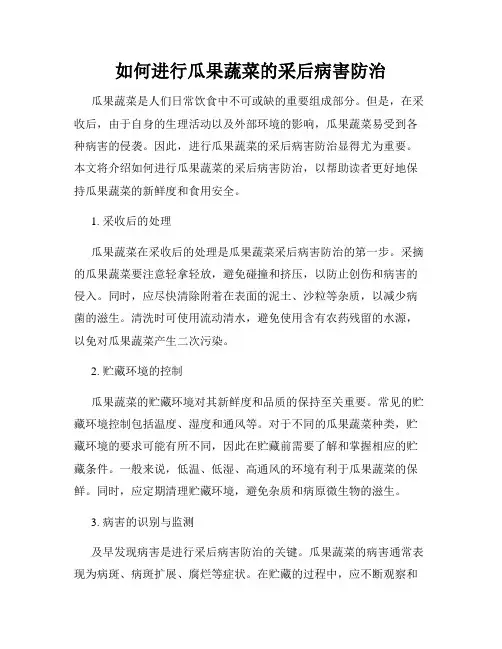
如何进行瓜果蔬菜的采后病害防治瓜果蔬菜是人们日常饮食中不可或缺的重要组成部分。
但是,在采收后,由于自身的生理活动以及外部环境的影响,瓜果蔬菜易受到各种病害的侵袭。
因此,进行瓜果蔬菜的采后病害防治显得尤为重要。
本文将介绍如何进行瓜果蔬菜的采后病害防治,以帮助读者更好地保持瓜果蔬菜的新鲜度和食用安全。
1. 采收后的处理瓜果蔬菜在采收后的处理是瓜果蔬菜采后病害防治的第一步。
采摘的瓜果蔬菜要注意轻拿轻放,避免碰撞和挤压,以防止创伤和病害的侵入。
同时,应尽快清除附着在表面的泥土、沙粒等杂质,以减少病菌的滋生。
清洗时可使用流动清水,避免使用含有农药残留的水源,以免对瓜果蔬菜产生二次污染。
2. 贮藏环境的控制瓜果蔬菜的贮藏环境对其新鲜度和品质的保持至关重要。
常见的贮藏环境控制包括温度、湿度和通风等。
对于不同的瓜果蔬菜种类,贮藏环境的要求可能有所不同,因此在贮藏前需要了解和掌握相应的贮藏条件。
一般来说,低温、低湿、高通风的环境有利于瓜果蔬菜的保鲜。
同时,应定期清理贮藏环境,避免杂质和病原微生物的滋生。
3. 病害的识别与监测及早发现病害是进行采后病害防治的关键。
瓜果蔬菜的病害通常表现为病斑、病斑扩展、腐烂等症状。
在贮藏的过程中,应不断观察和检查瓜果蔬菜的状况,一旦发现病害迹象,应立即进行处理。
同时,可以借助专业工具和设备对贮藏环境进行病害监测,掌握瓜果蔬菜的病害发展情况,以便采取相应措施进行防治。
4. 温湿度处理技术利用温湿度处理技术可以有效地控制瓜果蔬菜的病害。
常见的温湿度处理技术包括热处理、冷处理和湿热处理等。
热处理可以通过高温杀灭病原菌和孢子,有效防止病害的发生;冷处理则适用于一些对低温敏感的瓜果蔬菜,通过低温抑制和延缓病害的发展;湿热处理主要利用高温高湿的环境,破坏病原微生物的生长环境,达到防治病害的效果。
5. 化学防治技术化学防治技术是瓜果蔬菜采后病害防治的一种重要手段。
常用的化学防治方法包括喷洒药剂、浸泡药液和涂覆药物等。

BTH、SA处理对葡萄植株抗病性的诱导和对采后果实病害控制效果BTH、SA处理对葡萄植株抗病性的诱导和对采后果实病害控制效果植物作为一种生物体,面临着各种来自外界的生物和非生物压力,其中病害是一种常见的生物压力。
病害不仅影响着植物的生长发育和产量,还会导致果实质量的下降以及经济利益的损失。
因此,探索有效的病害控制方法对于植物产量和果实质量的提高具有重要意义。
近年来,研究表明,BTH(苯并咪唑嘧啶)和SA(水杨酸)处理可以诱导植物的抗病性,并对采后果实病害具有一定的控制效果。
BTH是一种化学物质,可以激活植物的防御系统,增强植物对病原微生物的抵抗能力。
SA是一种天然植物激素,在植物中起着重要的信号传导和抗病作用。
研究发现,对葡萄等作物进行BTH和SA处理能够显著提高植物的抗病性能力,从而减轻植物受病原微生物侵染的程度。
一方面,BTH和SA处理能够诱导植物的抗病性。
研究发现,BTH和SA处理能够激活植物的防御相关基因的表达,促进植物产生抗病酶和抗病物质,如过氧化物酶、抗菌肽等。
这些抗病酶和抗病物质的产生可以增强植物的抗病能力,从而减少植物受病原微生物侵染的风险。
此外,BTH和SA处理还能够调节植物的免疫系统,增加植物对病原微生物的识别和杀伤能力。
诱导植物的抗病性可以为植物有效抵御病原微生物的入侵提供了重要的保障。
另一方面,BTH和SA处理对采后果实病害的控制效果也值得关注。
采后果实病害是指果实在采后的储藏和运输过程中受到的病原微生物侵染所引起的病害。
这种病害不仅对果实的外观和口感产生不利影响,还会导致果实腐烂和质量下降。
研究发现,对采后的葡萄果实进行BTH和SA处理可以有效地控制果实病害的发生。
BTH和SA处理能够增强采后果实的抗病能力,减少病原微生物的侵染。
此外,BTH和SA处理还可以促进果实的硬度和抗氧化能力的提高,从而延长果实的储藏寿命。
综上所述,BTH和SA处理对葡萄植株抗病性的诱导和对采后果实病害的控制效果具有重要意义。
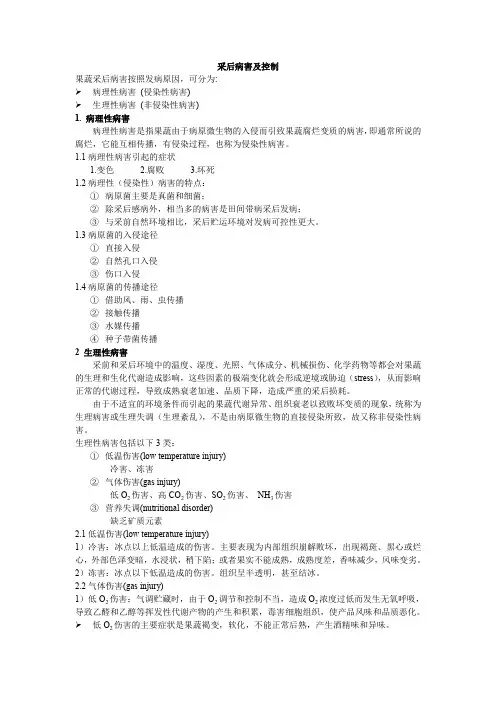
采后病害及控制果蔬采后病害按照发病原因,可分为:病理性病害(侵染性病害)生理性病害(非侵染性病害)1. 病理性病害病理性病害是指果蔬由于病原微生物的入侵而引致果蔬腐烂变质的病害,即通常所说的腐烂,它能互相传播,有侵染过程,也称为侵染性病害。
1.1病理性病害引起的症状1.变色2.腐败3.坏死1.2病理性(侵染性)病害的特点:①病原菌主要是真菌和细菌;②除采后感病外,相当多的病害是田间带病采后发病;③与采前自然环境相比,采后贮运环境对发病可控性更大。
1.3病原菌的入侵途径①直接入侵②自然孔口入侵③伤口入侵1.4病原菌的传播途径①借助风、雨、虫传播②接触传播③水媒传播④种子带菌传播2 生理性病害采前和采后环境中的温度、湿度、光照、气体成分、机械损伤、化学药物等都会对果蔬的生理和生化代谢造成影响,这些因素的极端变化就会形成逆境或胁迫(stress),从而影响正常的代谢过程,导致成熟衰老加速、品质下降,造成严重的采后损耗。
由于不适宜的环境条件而引起的果蔬代谢异常、组织衰老以致败坏变质的现象,统称为生理病害或生理失调(生理紊乱),不是由病原微生物的直接侵染所致,故又称非侵染性病害。
生理性病害包括以下3类:①低温伤害(low temperature injury)冷害、冻害②气体伤害(gas injury)低O2伤害、高CO2伤害、SO2伤害、NH3伤害③营养失调(nutritional disorder)缺乏矿质元素2.1低温伤害(low temperature injury)1)冷害:冰点以上低温造成的伤害。
主要表现为内部组织崩解败坏,出现褐斑、黑心或烂心,外部色泽变暗,水浸状,稍下陷;或者果实不能成熟,成熟度差,香味减少,风味变劣。
2)冻害:冰点以下低温造成的伤害。
组织呈半透明,甚至结冰。
2.2气体伤害(gas injury)1)低O2伤害:气调贮藏时,由于O2调节和控制不当,造成O2浓度过低而发生无氧呼吸,导致乙醛和乙醇等挥发性代谢产物的产生和积累,毒害细胞组织,使产品风味和品质恶化。
•Contents:1. Basic characteristic of fresh plant products.2. Losses and quality deterioration in fresh plant products after harvest.3. Factors influence fresh plant products quality.Chapter 0 Introduction•Contents:4. Contents of post-harvest biology and post-harvest physiology.5. Importance of post-harvest Biology in maintaining quality and decreasing loss of post-harvest fresh plant products.Chapter 1 Respiratory Metabolism•Objects:•To know concept and significance of respiration•To familiar with the process of respiratory metabolism•To know factors affecting respiration and the methods of respiration controlChapter 1 Respiratory Metabolism•Contents:•1. Introduction•2. Factors Affecting Respiration• 2.1 Temperature• 2.2 Atmospheric Composition• 2.3 Physical Stress• 2.4 Stage of Development•2.5 Other Factors (Type of plant products, Humidity, Disease or Insect Attack, Plant Growth Regulators, etc.)Chapter 1 Respiratory MetabolismSignificance of Respiration ;Shelf-life and Respiration Rate;Loss of Substrate;Synthesis of New Compounds;Release of Heat Energy ;Meaning of the Respiratoy Quotient (RQ);Measuring the Rate of Respiration ; Biochemistry of Respiration1 IntroductionAll of the commodities covered in this handbook are alive and carry on processes characteristics of all living things. One of the most important of these is respiratory metabolism.The process of respiration involves combing oxygen in the air with organic molecules in the tissue (usually a sugar) to form various intermediate compounds and eventually CO2 and water.The energy produced by the series of reactions comprising respiration can be captured as high energy bonds in compounds used by the cell in subsequent reactions, or lost as heat.The energy and organic molecules produced during respiration are used by other metabolic processes to maintain the health of the commodity.Heat produced during respiration is called vital heat and contributes to the refrigeration load that must be considered in designing storage rooms.In general, the storage life of commodities varies inversely with the rate of respiration.This is because respiration supplies compounds that determine the rate of metabolic processes directly related to quality parameters, e.g., firmness, sugar content, aroma, flavor, etc.Commodities and cultivars with higher rates of respiration tend to have shorter storage-life than those with low rates of respiration.Storage life of broccoli, lettuce, peas, spinach, and sweet corn (all of which have high respiration rates) is short in comparison to that of apples, cranberries, limes, onions, and potatoes - all of which have low respiration rates (Table 1).Table 1. Respiration rates of a range of perishable commoditiesClass Range at (mg CO2 kg-1 h-1)CommoditiesV ery Low < 5 Nuts, datesLow 5 to 10 Apple, citrus, grape,kiwifruit, onion, potatoModerate 10 to 20 Apricot, banana, cherry, peach,nectarine, pear, plum, fig, carrot,cabbage, lettuce, pepper, tomatoHigh 20 to 40 Strawberry, blackberry, bean, lima,avocado, raspberry, cauliflowerV ery High 40 to 60 Artichoke, snap bean,Brussels sprouts, cut flowersExtremely High > 60 Asparagus, broccoli, mushroom,pea, spinach, sweet corn 2 Factors Affecting RespirationRespiration is affected by a wide range of environmental factors that include:light,;chemical stress (e.g., fumigants);radiation stress, water stress, growth regulators, pathogen attack.The most important post-harvest factors are temperature,atmospheric composition,and physical stress.2.1 TemperatureWithout a doubt, the most important factor affecting post-harvest life is temperature.This is because temperature has a profound affect on the rates of biological reactions, e.g., metabolism and respiration.Over the physiological range of most crops, i.e., 0 to 30 °C, increased temperatures cause anexponential rise in respiration.The V an't Hoff Rule states that the velocity of a biological reaction increases 2 to 3-fold for every 10 °C rise in temperature.The temperature quotient for a 10 °C interval is called the Q10.The Q10 can be calculated by dividing the reaction rate at a higher temperature by the rate at a 10 °C lower temperature, i.e., Q10 = R2/R1.The temperature quotient is useful because it allows us to calculate the respiration rates at one temperature from a known rate at another temperature.However, the respiration rate does not follow ideal behavior, and the Q10can vary considerably with temperature.At higher temperatures, the Q10 is usually smaller than at lower temperatures.Typical figures for Q10 are:T emperature Q100 to 10 °C 2.5 to 4.010 to 20 °C 2.0 to 2.520 to 30 °C 1.5 to 2.030 to 40 °C 1.0 to 1.5These typical Q10values allow us to construct a table showing the effect of different temperatures on the rates of respiration or deterioration and relative shelf life of a typical perishable commodity (Table 2).Table 2. Effect of temperature on rate of deteriorationT emperature Assumed Relative velocity Relative(°C) Q10of deterioration shelf-life0 - 1.0 10010 3.0 3.0 3320 2.5 7.5 1330 2.0 15.0 740 1.5 22.5 4This table shows that if a commodity has a mean shelf-life of 13 days at 20 °C it can be stored for as long as 100 days at 0 °C, but will last no more than 4 days at 40 °C.Chilling stressAlthough respiration is normally reduced at low, but non-freezing temperatures, certain commodities, chiefly those originating in the tropics and subtropics, exhibit abnormal respiration when their temperature falls below 10 to 12 °C.Typically the Q10 is much higher at these low temperatures for chilling sensitive crops than it would be for chilling tolerant ones.Chilling stressRespiration may increase dramatically at the chilling temperatures or when the commodity is returned to non-chilling temperatures.This enhanced respiration presumably reflects the cells' efforts to detoxify metabolic intermediates that accumulated during chilling, as well as to repair damage to membranes and other sub-cellular structures.Chilling stressEnhanced respiration is only one of many symptoms that signal the onset of chilling injury.An economically important low temperature phenomenon discussed in more detail in a subsequent chapter.Heat stressAs the temperature rises beyond the physiological range, the rate of increase in respiration falls.It becomes negative as the tissue nears its thermal death point, when metabolism is disorderly and enzyme proteins are denatured (变性).Heat stressMany tissues can tolerate high temperatures for short periods of time (e.g., minutes), and this property is used to advantage in killing surface fungi on some fruits.Continued exposure to high temperatures causes phyto-toxic symptoms, and then complete tissue collapse.Heat stressHowever, conditioning and heat shocks, i.e., short exposure to potentially injurious temperatures, can modify the tissue‟s responses to subsequent harmful stresses.2.2 Atmospheric CompositionAdequate O2 levels are required to maintain aerobic respiration (有氧呼吸).The exact level of O2that reduces respiration while still permitting aerobic respiration varies with commodity.In most crops, O2level around 2 to 3% produces a beneficial reduction in the rate of respiration and other metabolic reactions.Levels as low as 1% improve the storage life of some crops, e.g., apples, but only when the storage temperature is optimal.At higher storage temperatures, the demand for A TP may outstrip(超过) the supply and promote anaerobic respiration (无氧呼吸).The need for adequate O2 should be considered in selecting the various post-harvest handling procedures, such as waxing and other surface coatings, film wrapping, and packaging.Unintentional modification of the atmosphere, e.g., packaging, can result in production of undesirable fermentative products and development of foul odors (异味).Increasing the CO2level around some commodities reduces respiration, delays senescence and retards fungal growth.In low O2 environments, however, increased CO2 levels can promote fermentative metabolism.Some commodities tolerate brief (e.g., a few days at low temperatures) storage in a pure N2 atmosphere, or in very high concentrations of CO2.High CO2 treatmentThe biochemical basis of their ability to withstand these atmospheres is unknown.2.3Physical StressWound respiration (伤呼吸)mechanical injuryinsect attackpathogen infectionchilling injurygas injuryWound-induced ethylene (伤害乙烯)Even mild (轻微的) physical stress can perturb (扰乱) respiration, while physical abuse can cause a substantial rise in respiration that is often associated with increased ethylene evolution.The signal produced by physical stress migrates from the site of injury and induces a wide range of physiological changes in adjacent (临近的), non-wounded tissue.Some of the more important changes include enhanced respiration, ethylene production, phenolic metabolism and wound healing.Wound-induced respiration is often transitory(短暂的), lasting a few hours or days.However, in some tissues wounding stimulates developmental changes, e.g., promote ripening, that result in a prolonged increase in respiration.Ethylene stimulates respiration and stress-induced ethylene may have many physiological effects on commodities besides stimulating respiration.2.4 Stage of DevelopmentRespiration rates vary among and within commodities.Storage organs such as nuts and tubers (坚果和块茎)have low respiration rates.Tissues with vegetative or floral meristems (分生组织) such as asparagus and broccoli have very high respiration rates.As plant organs mature, their rate of respiration typically declines.This means that commodities harvested during active growth, such as many vegetables and immature fruits, have high respiration rates.Mature fruits, dormant buds (休眠芽) and storage organs have relatively low rates.After harvest, the respiration rate typically declines; slowly in non-climacteric fruits(非跃变型果实)and storage organs, rapidly in vegetative tissues (营养组织)and immature fruits.The rapid decline presumably reflects depletion(消耗) of respirable substrates (呼吸底物) that are typically low in such tissues.An important exception to the general decline in respiration following harvest is the rapid and sometimes dramatic rise in respiration during the ripening of climacteric fruit (Fig. 1). climacteric fruit(跃变型果实)non-climacteric fruits(非跃变型果实)Figure1.The climacteric pattern of respiration in ripening fruit2.4 Stage of Developmentclimacteric fruit (跃变型果实)This rise, which has been the subject of intense study for many years, normally consists of four distinct phases:1) pre-climacteric minimum,2) climacteric rise,3) climacteric peak, and4) post-climacteric decline.The division of fruits into climacteric and non-climacteric types has been very useful for post-harvest physiologists.However, some fruits, for example kiwifruit and cucumber, appear to blur the distinction between the groups.Respiratory rises also occur during stress and other developmental stages, but a true climacteric only occurs coincident with fruit ripening.Following is a general classification of fruits according to their respiratory behavior during ripening:Climacteric Fruits Non-Climacteric FruitsApple Papaya Blueberry CitrusApricot Passion fruit Cacao LycheeA vocado Peach Caju LonganBanana Pear Cherry LoquatBiriba Persimmon CucumberBreadfruit PlumGrape Cherimoya Sapote GrapefruitFeijoa Soursop LemonFig Tomato LimeGuava Watermelon OliveJackfruit OrangeKiwifruit PepperMango PineappleMuskmelon StrawberryNectarine TamarilloDifferences between climacteric fruits and non-climacteric fruits1、概念:C a r b o n d i o x i d e p r o d u c t i o n2、呼吸强度大小:3、乙烯产生量大小:4、乙烯合成系统:5、对外源乙烯的反应:(施用时期、乙烯浓度)6、呼吸高峰:7、耐贮性:8、后熟性:Different kinds of agricultural product can not store at the same storage room, especially climacteric fruits and non-climacteric fruits(1)不同的农产品其贮藏的条件。
酵母菌对果蔬采后病害的生物防治摘要:采用生防菌进行果蔬采后病害的生物防治是一种安全有效的方法,酵母菌因其拮抗效果好、不产生毒素、可以和化学杀菌剂共同使用等优点,备受人们关注。
该文对酵母菌对果蔬采后病害防治的研究现状进行了综述, 其中包括防治效果、防治机理、防治的优势。
许多酵母菌对果蔬采后病害具有明显的抑制作用, 酵母菌抑制霉菌的机理主要在于营养与空间的竞争、对病原菌的直接寄生作用及诱导寄主产生抗病性。
该文还分析了酵母菌在果蔬采后病害生物防治中存在的问题,拮抗酵母菌商业化应用的局限性,并对其发展前景进行了展望。
关键词:生物防治;酵母菌;采后病害前言果蔬采后病害导致的巨大损耗己成为全球性的问题,造成采后果蔬腐烂变质的原因有自身的生理失调和衰老,病原菌侵染以及采收贮运过程中的机械损伤等,其中以病原微生物侵染为主。
在发达国家约有10%~30%的新鲜果品由于采后病害导致腐烂损失,而在发展中国家,由于缺乏贮运冷链设备,腐烂损失率则更高,达40%~50%[1]。
据报道,中国每年因采后腐烂导致的果蔬损失约8000万t,造成经济损失约750亿元,占全国果蔬产业总值的30%以上[2]。
长期以来,防治果蔬采后病害的方法主要是采用化学杀菌剂,然而,化学杀菌剂毒性较大,易污染环境。
目前越来越多原先用于果蔬采后处理的化学杀菌剂己被禁止使用,如苯来特、多菌灵、双胍盐等[1]。
此外,频繁使用化学杀菌剂会使病原菌产生抗药性而逐渐降低其防治效果,为达到灭菌效果不得不增加剂量,从而造成果蔬农药残留超标,危害人类的健康。
因此,迫切需要寻求一些新的、无毒高效的防腐技术,以逐步取代化学杀菌剂在采后果蔬上的使用。
用微生物进行采后病害的生物防治是近年来发展起来的一个新的研究领域。
自从20世纪50年代Guter等首次报道枯草杆菌(Bacillus Subtilis)对水果病原菌有拮抗作用以来,国外学者对用微生物拮抗菌对果蔬采后病害的防治进行了广泛的研究。